Related Research Articles
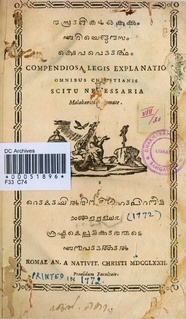
Malayalam, the Lingua franca of the Indian state of Kerala and the union territories of Lakshadweep and Puduchery, is one of the six Classical languages of India. Malayalam literature comprises those literary texts written in Malayalam, a South-Dravidian language spoken in the Indian state of Kerala. The first travelogue in any Indian language is the Malayalam Varthamanappusthakam, written by Paremmakkal Thoma Kathanar in 1785. Malayalam literature has been presented with 6 Jnanapith awards, the second-most for any Dravidian language and the third-highest for any Indian language.
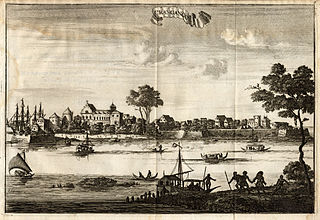
Kodungallur, IPA: [koɖuŋːɐlːuːr], is a historically significant town situated on the banks of river Periyar on the Malabar Coast in Thrissur district of Kerala, India. It is situated 29 kilometres (18 mi) north of Kochi (Cochin) by National Highway 66. Kodungallur, being a port city at the northern end of the Kerala lagoons, was a strategic entry point for the naval fleets to the extensive Kerala backwaters.
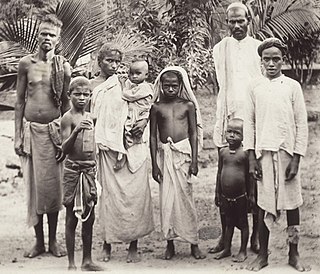
Mappila Muslim, often shortened to Mappila, formerly anglicized as Moplah/Mopla and historically known as Jonaka/Chonaka Mappila or Moors Mopulars/Mouros da Terra and Mouros Malabares, in general, is a member of the Muslim community of same name found predominantly in Kerala and Lakshadweep Islands, in southern India. Muslims of Kerala make up 26.56% of the population of the state (2011), and as a religious group they are the second largest group after Hindus (54.73%). Mappilas share the common language of Malayalam with the other religious communities of Kerala.

Oppana is a popular form of social entertainment among the Mappila community of Kerala, South India, prevalent throughout Kerala, especially in Malappuram. The Term Oppana is believed to be originated from the Arabic word "Affna" Oppana was originated on the occasion of make of Muslim brides.. But in Kerala, this art form has been revived with much popularity on the performing stages of the Youth Festivals of the student community.

The culture of Kerala has developed over the past millennia, influences from other parts of India and abroad. It is defined by its antiquity and the organic continuity sustained by the Malayali people. Modern Kerala society took shape owing to migrations from different parts of India and abroad throughout Classical Antiquity.
Mappila songs are a folklore Muslim song genre rendered to lyrics, within a melodic framework (Ishal), in Arabi Malayalam by the Mappilas of the Malabar region in Kerala, India. Mappila songs have a distinct cultural identity, while at the same time remain closely linked to the cultural practices of Kerala.
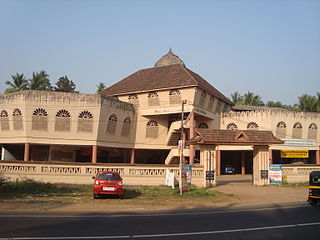
Moyinkutty Vaidyar (1852–1892), often referred to as Mahakavi, is historically considered one of the most renowned poets of the Mappila pattu genre of Malayalam language.

Kondotty is a developing town, municipality, and aerotropolis in the Malappuram district state of Kerala, India which is located near Calicut International Airport, 24 km from Malappuram. It is the headquarters of Kondotty Taluk, which was declared as the seventh taluk in Malappuram district by chief minister Oommen Chandy on 23 December 2013.

Dharmadom or Dharmadam is a census town in Thalassery taluk of Kannur district in the state of Kerala, India. This town is located in between Anjarakandi River and Ummanchira river, and Palayad town and Arabian sea. It is known for the 100-year-old Government Brennen College and Dharmadam Island. Dharmadam is also home to famous Andaloor Kavu. The annual festival here draws thousands of devotees. A variety of theyyams are performed during the week-long fest in February. During the festive season the entire village follows vegetarian diet and offers rice flakes, jaggery and plantains to all guests. India's premier circus Academy, Circus Academy Thalassery is also located at Dharmadam. There is a small railway station in Dharmadam where only the local passenger trains stop.

Islam arrived in Kerala, the Malayalam-speaking region in the south-western tip of India, through Middle Eastern merchants. The Indian coast has an ancient relation with West Asia and the Middle East, even during the pre-Islamic period

The Cheramaan Juma Mosque is a mosque in Methala, Kodungallur Taluk, Thrissur District in the Indian state of Kerala. A legend claims that it was built in 629 CE, which makes it the oldest mosque in the Indian subcontinent which is still in use. It was built by Malik Deenar, Persian tābiʿūn of the Islamic prophet Muhammad, on the orders of the successor of Cheraman Perumal, the Chera King of modern-day Kerala. The mosque was constructed in Kerala style with hanging lamps, making the historicity of its date claims more convincing.
'Tuhfat al-Mujahidin fi ba‘d Akhbar al-Burtughaliyin' is a historical work by Zainuddin Makhdoom II on the struggle between the Mappila Muslims of Malabar and South Canara and Portuguese colonial forces in the 16th century. It is the first historical work of Kerala to be authored by a keralite. The book describes the resistance put up by the navy of Kunjali Marakkar alongside the Zamorin of Calicut from 1498 to 1583 against Portuguese attempts to colonize the Malabar coast. Along with chronological events of the era, the book also provides an analysis of the events, as well as the lifestyle, customs and family structure of the people of the time.
Arabi Malayalam script, also known as Ponnani script, is a writing system - a variant form of the Arabic script with special orthographic features - for writing Arabi Malayalam, a Dravidian language in southern India. Though the script originated and developed in Kerala, today it is predominantly used in Malaysia and Singapore by the migrant Muslim community.

M N Karassery
The legend of Cheraman Perumals is the medieval tradition associated with the Cheraman Perumals of Kerala. The sources of the legend include popular oral traditions and later literary compositions. The time of origin of the legend is not known to scholars. It seems the legend once had a common source well known to all Kerala people.
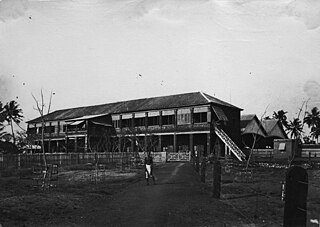
Chaliyam is a village situated at the estuary of Chaliyar in Kozhikode district of Kerala, India. Chaliyam forms an island, bounded by the Chaliyar in the north, and River Kadalundi in south, and the Conolly Canal in the east. It is located just opposite to Beypore port. Chaliyam was the former terminus of the South-West Line of the Madras Railway. Chaliyam is also famous for the Guinness World Records holder Muhammed Adil, a P.M who covered around seven km in the Chaliyar River with his hand and legs tied with ropes.
Madayi Mosque is mosque at Pazhayangadi in Kannur district, northern Kerala. It is one of the oldest mosques in Kerala, with local legends dating back to 7th century AD. It is believed to have been established by Malik ibn Dinar and contains a block of white marble said to have been brought from Mecca by ibn Dinar. It is one of the several mosques around Pazhayangadi/Payangadi. It is situated on the banks of Kuppam River, which joins Valapattanam River at its estuary.

The Maha Kavi Moyinkutty Vaidyar Smarakam is a memorial building dedicated to Moyinkutty Vaidyar (1852–1892), often referred to as Mahakavi, who is historically considered as one of the most renowned poets of the Mappila pattu genre of Malayalam language.
Pulath Pulikkottil Hyder was a popular poet who composed short songs in Arabi-Malayalam on topics of common interest, often attacking social evils. His simple lyrics on ordinary life of the Mappilas defied the traditional patterns of Mappilappattu thus giving him the name "The Kunchan Nambiar of Mappilappattu". In Vellappokka Maala, he describes a heavy flood that affected all throughout the Malabar, Mysore and Travancore. The sufferings of common men in the flood are depicted beautifully using only ordinary Malayalam vocabulary. The Pulikkotil Hyder Smaraka Puraskaram, instituted by the Mahakavi Moyinkutty Vaidyar Smaraka Committee and given to personalities who have contributed to the art of Mappilappattu is named after him. The foundation for a memorial for the poet was laid in his hometown Wandoor by former Chief Minister of Kerala C.H. Mohammed Koya in April 1979, but the work has remained incomplete ever since. In 1979, the Mappila Kala Sahithya Vedi published a compilation of his works titled "Pulikkottil Krithikal".

C. N. Ahmad Moulavi was an Indian writer of Malayalam literature, best known as the translator of the first complete publication of Quran in Malayalam. He was the author of a number of books on Islam and was reported to have contributed to the propagation of education among the Muslims of Malabar region. A member of the Kerala Sahitya Akademi during the period 1959–64, Moulavi was honoured by the academy with the distinguished fellowship in 1989.
References
- 1 2 "Mappila Muslims: A Study on Society and Anti Colonial Struggles" By Husain Raṇṭattāṇi.
- ↑ Abdurahiman.K.P "Mappila heritage: A study in their social and cultural life" Thesis. Department of History, University of Calicut, 2004.
- 1 2 Abdurahiman.K.P "Mappila heritage: A study in their social and cultural life" Thesis. Department of History, University of Calicut, 2004. Chapter~7 'Mappila Tradition In Folk Arts'.
- ↑ "Mappilapaattu or Mappila songs | Muslim songs of Kerala".
- 1 2 Ishal Thanima Audio CD, Mahakavi Moyinkutty Vaidyar Mappila Kala Academy, Kondotty, Kerala.
- ↑ "Mappila Muslims: A Study on Society and Anti Colonial Struggles" By Husain Raṇṭattāṇi.
- ↑ "Mappilapattu version of Ramayana soon" Times of India, 23 July 2017.
- ↑ "Islamika Vinjanakosham", Islamic Publishing House, vol. 7 & 8